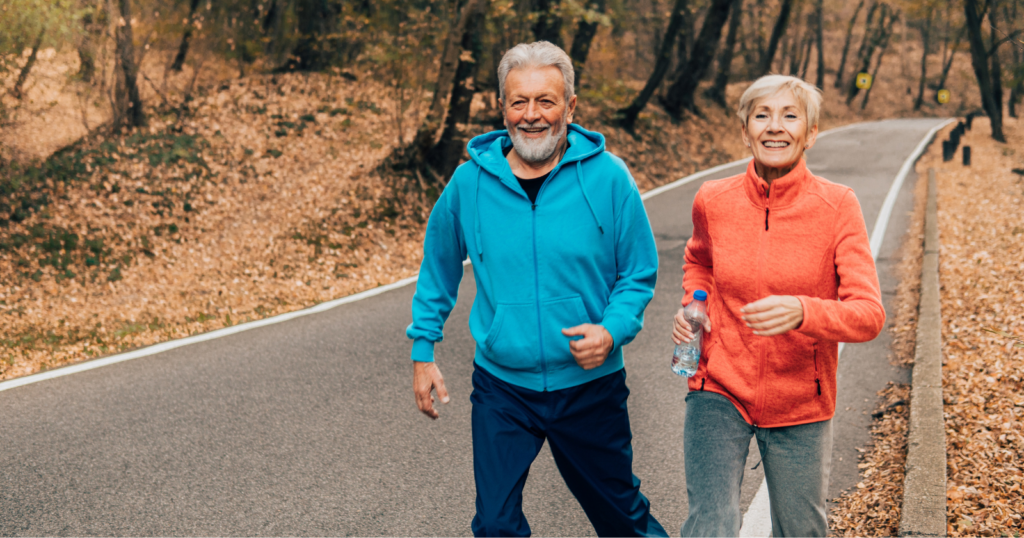There’s an older man I pass almost every morning on my walk.
He’s probably in his 70s. He wears the same sun-faded cap, walks with a soft rhythm, and waves at just about everyone who crosses his path.
He doesn’t look like someone who’s “exercising.”
But his posture is upright, his steps are steady, and you can tell—he feels good in his body.
That’s what I’ve come to believe aging well really looks like.
Not six-pack abs or marathon medals.
Just freedom in your body. Lightness in your step. The ability to move through the world without strain.
And the good news? That kind of vitality isn’t only for fitness fanatics.
Here are a few low-effort habits that truly make a difference—especially over time.
1. They walk daily, even for just 15 minutes
You don’t need a gym membership to stay mobile.
People who age well often have one simple habit in common: they move every day.
Not intensely. Not competitively.
Just enough to keep their joints lubricated, their blood flowing, and their mood elevated.
Walking is one of the most underrated forms of exercise.
It improves heart health, supports balance, and clears mental fog.
Even a short walk after dinner can make a big difference.
2. They stretch while waiting
When I first started adding more stretching into my day, I didn’t set aside a formal “yoga hour.”
I started while waiting for the kettle to boil or brushing my teeth.
A few shoulder rolls. A hamstring stretch with one foot on the bathroom counter.
It may not sound like much—but over time, it added up.
People who stay fit into their later years often treat movement as a lifestyle, not a task.
They sneak flexibility into everyday moments.
3. They prioritize quality sleep
This one might not sound like a “fitness” habit at first glance.
But restorative sleep is crucial for muscle repair, hormone regulation, and energy levels.
Older adults who stay active often report consistent sleep routines: going to bed at the same time, avoiding screens late at night, and creating calming wind-down rituals.
Good sleep makes movement easier.
And movement, in turn, improves sleep.
It’s a self-supporting cycle.
4. They drink water before they feel thirsty
Hydration may sound simple, but it plays a huge role in energy, joint comfort, and digestion.
People who remain active into older age tend to have small, consistent hydration habits:
- A glass of water first thing in the morning
- Sipping between meals
- Carrying a refillable bottle when out and about
They don’t wait until they’re dehydrated to catch up.
They build hydration into the rhythm of their day.
5. They sit on the floor (and get back up)
One of the simplest indicators of long-term mobility is whether you can get up from the floor without using your hands.
People who stay fit into old age often practice this unconsciously.
They read on floor cushions, stretch near the sofa, or eat picnic-style in the garden.
These micro-movements engage muscles that help with balance, flexibility, and joint strength.
It’s low-effort—but surprisingly effective.
6. They carry their own groceries
I remember watching my grandmother insist on carrying her grocery bags well into her 80s.
She wasn’t trying to prove anything.
She just believed in using her strength while she still had it.
Carrying moderate weight during daily life helps maintain grip strength, joint stability, and muscle tone.
You don’t need to lift heavy.
You just need to keep lifting something.
7. They build fun into their movement
Before we finish, I want to share a quick story.
My husband’s aunt is in her late 60s, and she’s never liked the gym.
But she dances.
Every Saturday morning, rain or shine, she attends a community salsa class.
She’s not doing it to “stay fit.” She’s doing it because it makes her feel alive.
And that’s the magic of sustainable movement.
People who stay active long-term usually find joy in it.
They garden, they hike, they swim, they play with grandkids.
They don’t frame movement as punishment or obligation.
They let it become play.
8. They embrace imperfection
I used to think you had to be perfectly disciplined to stay fit.
But over the years, I’ve learned it’s actually the grace you offer yourself that sustains the habit.
People who stay physically well into old age don’t follow rigid routines.
They forgive themselves when they miss a day. They adjust when life gets busy.
They listen to their bodies.
They keep showing up—even if it’s slower, gentler, or different than it used to be.
As Rudá Iandê puts it in his book Laughing in the Face of Chaos:
“When we let go of the need to be perfect, we free ourselves to live fully—embracing the mess, complexity, and richness of a life that’s delightfully real.”
That quote has helped me return to movement more than once—without guilt, just with presence.
9. They pause to breathe with intention
It sounds almost too easy.
But taking 30 seconds to breathe deeply—shoulders down, jaw unclenched—activates your parasympathetic nervous system.
That’s your rest-and-digest mode.
People who age well often breathe with awareness.
During walks. Before sleep. While waiting in line.
That calm awareness supports heart health, digestion, and emotional balance.
It doesn’t require a mat or an app—just a pause.
10. They stay curious about their bodies
We’re almost done, but this piece can’t be overlooked.
People who remain fit into their 60s, 70s, and beyond often have a deep respect for their bodies—not because they’re flawless, but because they’re alive.
They notice sensations.
They respond to stiffness with movement, not frustration.
They celebrate strength, even when it’s subtle.
This curiosity creates a relationship with the body—not just a to-do list.
Rudá Iandê expressed this beautifully:
“Your body is not just a vessel, but a sacred universe unto itself, a microcosm of the vast intelligence and creativity that permeates all of existence.”
That lens shift—from discipline to dialogue—changes everything.
Final thoughts
Fitness doesn’t have to be intense to be effective.
And aging doesn’t have to mean decline.
If you build small, sustainable habits today, your future self will thank you.
So pick one thing from this list.
One breath.
One walk.
One stretch before bedtime.
Let it be enough—for now.
Because consistency, not perfection, is what keeps us moving through life with grace.







